

Dp120904.pdf (Objet application/pdf) The State of Web Design Trends: 2011 Annual Edition. Burson-Marsteller Global Social Media Check-Up 2012. C&A Fashion Like - Video Case. Proving social media success is all about analytics. Mary Meeker's Latest Incredibly Insightful Presentation About The State Of The Web. La recherche passe à l’ère sémantique (et sociale) (et pas visuelle) New York Times R&D Group Launches First Commercial Product.
Rethinking Facebook’s role in ‘f-commerce’ Study: Blogging in decline as social media takes over - Blogs & Content. Back in 2010, half of companies had a corporate blog.
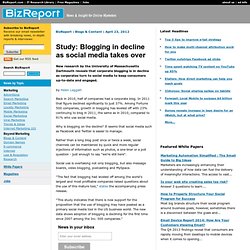
In 2011 that figure declined significantly to just 37%. Among Fortune 500 companies, growth in blogging has leveled off with 23% continuing to blog in 2011, the same as in 2010, compared to 91% who use social media. Why is blogging on the decline? It seems that social media such as Facebook and Twitter is easier to manage. How Facebook Open Graph can enhance a marketing campaign. Social Media: LinkedIn vs. Facebook. Facebook And Instagram Represent An Important Shift In Social Marketing Strategy.
“It seems that Facebook acquired Instagram for two reasons,” Roger Katz, CEO of Friend2Friend, tells WebProNews.
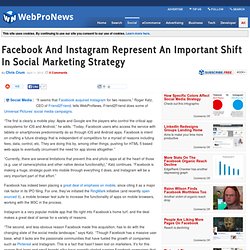
Friend2Friend does some of Universal Pictures’ social media campaigns. “The first is clearly a mobile play: Apple and Google are the players who control the critical app ecosystems for iOS and Android,” he adds. “Today, Facebook users who access the service with tablets or smartphones predominantly do so through iOS and Android apps. Facebook is intent on crafting a future strategy that is independent of competitors for a myriad of reasons including fees, data, control, etc. They are doing this by, among other things, pushing for HTML 5 based web-apps to eventually circumvent the need for app stores altogether.”
“Currently, there are several limitations that prevent this and photo apps sit at the heart of those (e.g. use of camera/photos and other native device functionality),” Katz continues. Facebook Delves Deeper Into Search. On Feb. 1, a few hours after Facebook declared its intention to raise $5 billion in what will likely be the largest initial public offering in tech history, Mark Zuckerberg gave close followers of his company a potential clue to its future.

On his Facebook profile, he uploaded a photograph of his desk and a large sign that read in big red letters, “Stay focused & keep shipping.” Yet it was the adjacent MacBook laptop in the image that drew the most attention. How Pinterest Can Get Your Brand Attention [INFOGRAPHIC] If your brand isn't on Pinterest, you could be missing out on a growing stream of potential customers.
![How Pinterest Can Get Your Brand Attention [INFOGRAPHIC]](http://cdn.pearltrees.com/s/pic/th/pinterest-brand-infographic-25274216)
While shaping your brand's image on Pinterest, remember to take into account the specifics of the site's userbase. A recent study showed that home, arts and crafts, style/fashion and food are the most popular categories on Pinterest. The food category is the fastest growing segment of Pinterest. Newspapers: It’s not a revenue problem, it’s a culture problem.
Facebook Brand Timelines: 6 Big Changes Every Marketer Needs to Understand. Victoria Ransom is founder and CEO of Wildfire Interactive, the global leader in social media marketing software.
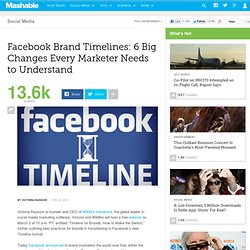
Victoria and Wildfire will host a free webinar on March 2 at 10 a.m. PT, entitled “Timeline for Brands: How to Make the Switch,” further outlining best practices for brands in transitioning to Facebook’s new Timeline format. Today Facebook announced to brand marketers the world over that, within the month, everything they knew about fan Pages on Facebook would be overturned. While you get your brand ready for the new Timeline format, here are six important changes to keep top-of-mind. 1. Why Content for SEO? ‹ Infographics « Brafton. Etude marché, Conseil en stratégie : Marketing, Communication entreprise, Relation client - La Poste entreprise : Le'Hub.
Five online advertising trends to expect in 2012. The Death of the Cyberflâneur. INfluencia tendance / Du BrandContent à la Brand Culture. Question de vocabulaire Brand content, oui. The Mounting Minuses at Google+ [Naro] Minded — Brand. New Media. Inspiration. Crowdsourcing As A Service: Citizen Reporters, Mystery Shoppers and Intelligence Gathering. Copyrighted image courtesy EMT/Stringfly Smartphones aren’t just great devices for communication and consumption; they’re also incredibly powerful tools for gathering information.
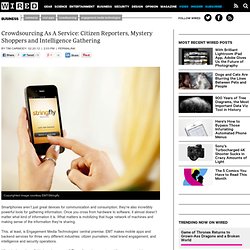
Once you cross from hardware to software, it almost doesn’t matter what kind of information it is. What matters is mobilizing that huge network of machines and making sense of the information they’re sharing. This, at least, is Engagement Media Technologies’ central premise. EMT makes mobile apps and backend services for three very different industries: citizen journalism, retail brand engagement, and intelligence and security operations. Sebastian Wernicke: 1000 TEDTalks, 6 words. Quand le web sémantique simplifie la recherche d'avis. Eat&Drink fédère l'ensemble des commentaires sur un lieu et analyse le contenu afin de fournir une synthèse sous forme de critères et de notes.
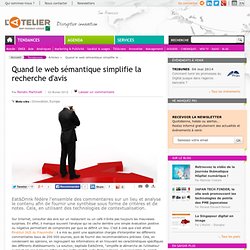
Cela, en utilisant des technologies de contextualisation. Sur Internet, consulter des avis sur un restaurant ou un café n'évite pas toujours les mauvaises surprises. En effet, il manque souvent l'analyse qui se cache derrière une simple évaluation positive ou négative permettant de comprendre par quoi se définit un lieu. C’est à cela que s’est attelé l’institut IAIS du Fraunhofer : il a mis au point une application chargée d’interpréter les différents commentaires issus de 200 000 sources, puis de fournir des recommandations précises. Cela, en condensant les opinions, en regroupant les informations et en trouvant les caractéristiques spécifiques des différents établissements.